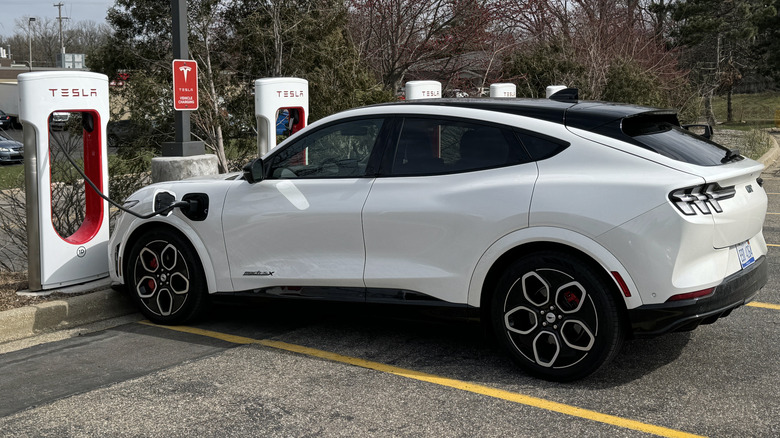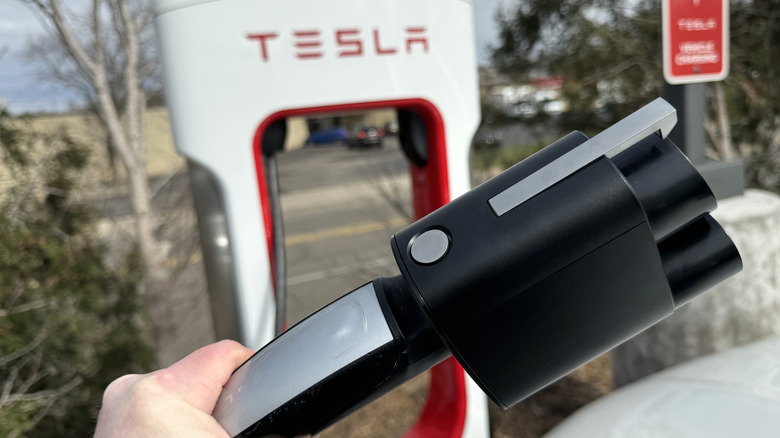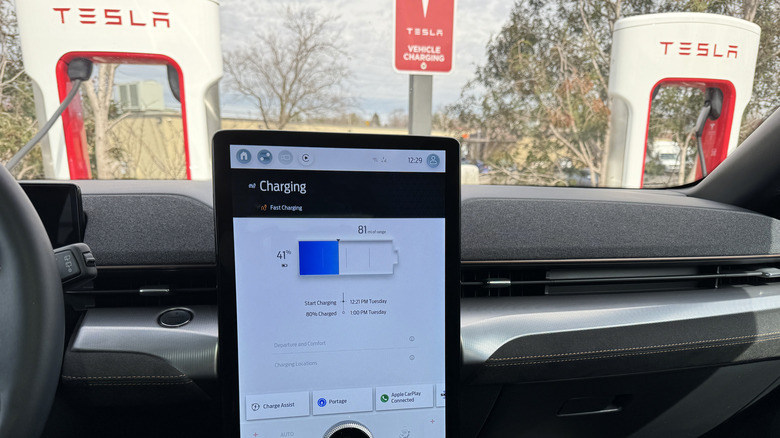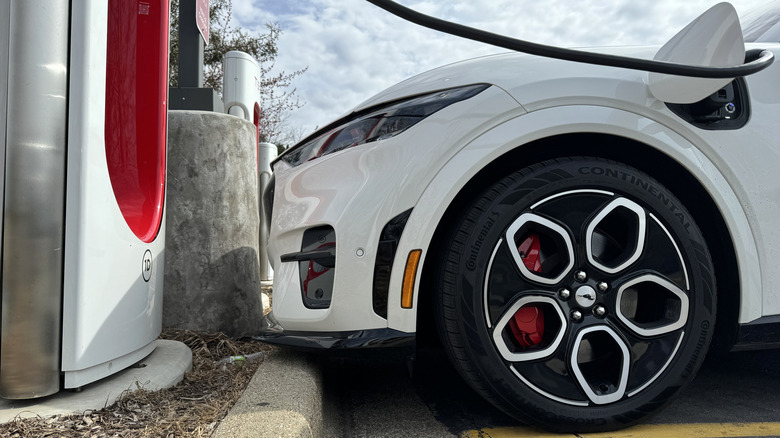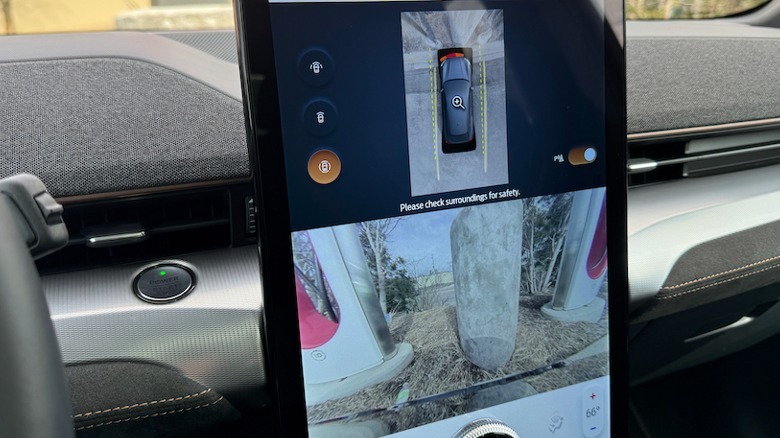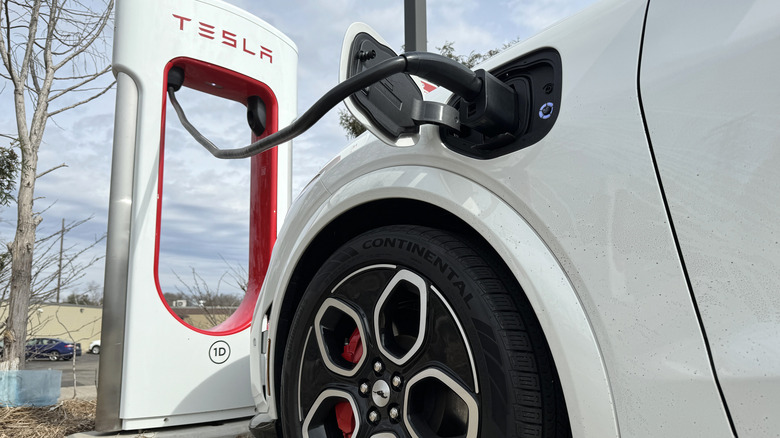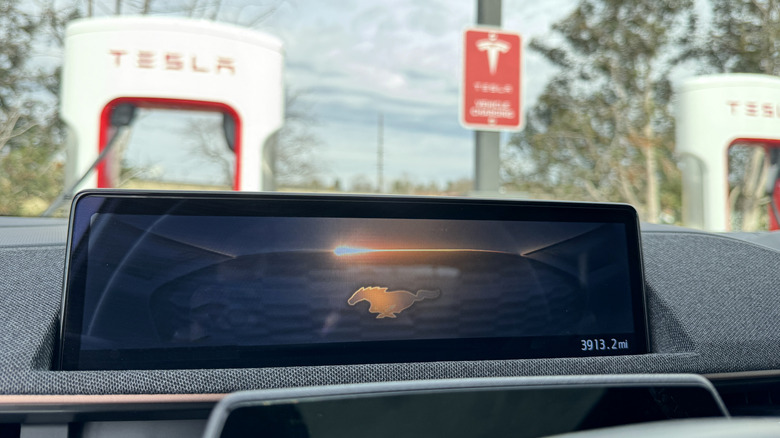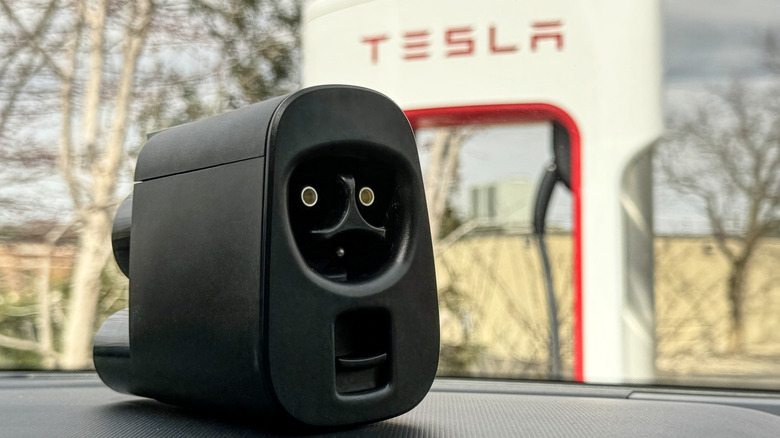I Took A Ford EV To A Tesla Supercharger: Here's What Worked And What Didn't
Until now, a Ford EV at a Tesla Supercharger has been about as welcome as a big, gas-guzzling pickup truck protest-blocking the stations altogether. Times change, though, and what once was an exclusive perk for Elon Musk's customers is readying for a huge potential influx of other electric cars. To see just what that might be like, Ford tossed me the keys to a Mustang Mach-E GT, complete with its NACS to CCS adapter in the glove compartment.
The tedious debate about whether it deserves the "Mustang" badge aside, there's been a lot to like about the Mach-E since Ford launched it in late 2020. What Ford didn't do, though, was also build out a charging network of its own. Instead, it corralled third-party providers into the BlueOval Charging Network, many of which support a single payment system through the FordPass app.
Tesla, then, is, on the one hand, simply the latest of those providers to be added in. At the same time, its inclusion more than doubles the number of DC fast charger plugs a Ford EV driver has access to — taking it to approximately 28,000 across North America — at around 7,500 locations. That's huge no matter how you look at it, and so I was curious to discover whether the real-world experience lived up to Ford's big promises.
A simple adapter opens up a new world of charging
Ford's adapter is a sturdy, surprisingly hefty affair for something so straightforward: push the Supercharger's NACS plug in on one side and then connect the adapter's CCS plug on the opposite end into the EV. Its metal-wrapped body is weatherproof and could probably survive a few drops onto concrete, too, though I figured Ford wouldn't be too keen on my testing that in practice.
Finding a place to use it is best done through Ford's maps, not Tesla's. Not every Supercharger is compatible with non-Tesla cars — any V2 stations aren't usable, though select V3 locations are also excluded — so mapping it out in the FordPass app is easier. There, you get a list of how many bays there are, their power level, how many are currently in use, and how much you'll pay.
Rates vary by location, but my nearest Supercharger was priced at $0.46 per kWh delivered (with $1/minute idle fees if you left a non-charging car plugged in for more than five minutes). That compared favorably to a nearby Electrify America station, which was asking $0.56/kWh, though if I'd driven 25 miles further, I could've paid $0.40/kWh at an EV Connect station at a Ford dealership. An alternative Supercharger location, meanwhile, was priced per hour plugged in rather than according to the power actually delivered.
Frankly, it can be a little confusing to figure out just what you'll end up paying, particularly given that DC fast chargers rarely seem to deliver at their theoretical peak rates.
Getting the fastest charge takes more than just Tesla
Getting those maximum speeds is often about arriving with your car in the best possible condition for fast charging, and that typically means going through battery preconditioning. In Michigan, during March, that generally involves heating the battery pack until it's at a temperature most conducive to the fastest rates your EV supports. Usually, that's all initiated automatically and in the background by the EV itself, when you choose a charger as a destination in the in-built navigation.
Unfortunately, the Mach-E's system doesn't yet show Superchargers, and — as frustrated me recently in Rivian's dual-motor R1T – there isn't an option to manually trigger preconditioning (or launch it from the FordPass app). As problems go, it's one of the easiest for Ford to address since the Mustang has an embedded data connection to receive charger database updates, among other OTA changes. The automaker tells me it's working with its navigation provider to get Tesla locations added.
Screaming parking sensors and lucky bumpers
Pulling up to the bank of Superchargers, I was happy to see that the usage status reported in the FordPass app was correct: only two out of the eight bays were occupied. It felt a little strange to nose the Mustang Mach-E in toward a charger, and I half expected some "helpful" passerby to tell me that only Tesla owners could use this particular station.
My sole welcome, though, was a head nod from one guy waiting in his plugged-in Model S, who then got to watch me minutely reposition the Ford for the next five minutes. Unlike, say, Electrify America or EVgo chargers, I discovered Tesla is miserly to the point of ridiculous with the length of its charging cables. You might assume they pull out of the Supercharger to reach, but no, they don't.
That's fine when your charging port is built into the rear taillight cluster, as on Tesla's EVs. The Mustang Mach-E's is on the driver's side fender, however, and getting that truncated cable to connect involved ignoring the increasingly frantic parking sensors and holding my breath as the low front spoiler of the GT-spec Ford came perilously close to the concrete curb. Eventually, scratches thankfully absent, I managed to pull the cord across sufficiently, though it did tug the adapter to the side once plugged in.
Plug & Charge feels like magic
Not all Superchargers are oriented the same way, and indeed, at the site I visited, there was one on an adjacent curb, which would've made plugging in a side-mounted charging port far easier. Unfortunately, that was one of the two already occupied when I arrived. Ford tells me that Tesla is working to improve access based on the assumption that not all EV charge ports are located equally, but for the moment, I hope you have parking sensors and nerves of steel.
With payment details already registered in the FordPass app, Plug & Charge took care of the digital handshake, and within a few seconds, the EV was charging. On the Mustang Mach-E's central touchscreen, you can see the current battery level, the maximum charge setting — Ford, like other automakers, recommends 80% in the name of battery longevity — and an estimate of when charging will be complete. If you want to see the actual charging rate and other details, however, that's in the FordPass app.
There, the metrics include your current charging levels, how much power has been added — in kWh and estimated miles of driving — and how long you've been plugged in. In theory, at the 250 kW Supercharger, I should have been able to take the GT's 91 kWh (usable) battery from 10% to 80% in under 30 minutes. In fact, with peak speeds — according to the app — never reaching 100 kW, it took 36 minutes to go from around 36% to 80% and cost $22.08.
Are Tesla owners ready to share?
It's entirely possible that better battery preconditioning could've trimmed that time, or indeed, had I plugged in on a warmer day (it was a crisp 44 Fahrenheit). And sporadic charging rates certainly aren't only a Supercharger issue. Plugging into any public DC fast charger can be a crapshoot when it comes to what peak speed you'll see, and figuring out whether it's the car to blame, the station, or the universe simply looking at you unkindly that day is often impossible.
While I waited, I chatted with the owners of a Model 3 who had been shopping in the nearby Meijer grocery store while their Tesla charged. My biggest curiosity with this expanded Supercharger access is just how Tesla drivers will react: so far, for the most part, they've had the stations to themselves. Over the coming months, EVs from just about every other automaker will be turning up, hunting for a charge, and you could imagine the Tesla faithful finding that off-putting.
That's not necessarily the case, at least according to the couple I spoke to — hardly a scientific survey, I'll be the first to agree — who seemed open-minded about the prospect of greater EV adoption and perhaps even more investment in Supercharger deployment, too. Currently, with only Ford and Rivian having enabled Supercharger access for their fleets (and Ford drivers not set to receive their free adapters until the end of the month), we're still in the wait-and-see stage as to how station availability pans out.
More competition is better for every EV owner
With the car at 80%, I hit the button alongside the Mach-E's charging port to release the plug and then set to extricate the Supercharger's cable from Ford's adapter. There's a small latch just underneath where the NACS plug slots in, and trying to depress that while also pulling the cable and holding the adapter is surprisingly tricky. At least you'll be unlikely to leave the adapter behind (a $230 prospect) since the CCS plug won't dock into the Supercharger's plug clip like the NACS one does.
Overall, even with cable length foibles to contend with, my experience with the Mustang Mach-E at a Tesla Supercharger ran smoother than a lot of public fast charger encounters I've had with other EVs in the past. Arguably as valuable as Tesla's infrastructure spread has been, is the consistency of the experience. Rolling up in the Ford, plugging in, and having Plug & Charge handle the minutiae felt like an example of how charging away from home should work, and it'll only get easier from 2025 when Ford (like other EV-makers) adopts the NACS plug natively on its new cars in North America.
Only time will tell how hectic Supercharger locations get when more EVs are able to use them and if Tesla's consistency sustains when its chargers have to deal with an exponential increase in different vehicles and their software. In an ideal world, other DC fast charger networks — both existing and upcoming projects like Ionna backed by seven different automakers — will feel the heat and raise their game to better compete. After all, with range anxiety still one of the biggest barriers to electric vehicle adoption, giving people more places to plug in and a better experience while doing so can only be a good thing.
